Kept properly, a basilisk lizard may add a new wrinkle to your reptile keeping hobby.
There are four species of basilisk lizard (Basiliscus plumifrons, B. basiliscus, B. galeritus and B. vittatus), and the focus of this article will be on the two with which I have worked for years: the green basilisk (B. plumifrons), which is generally considered the most visually striking of the basilisks, and the striped basilisk (B. vittatus).
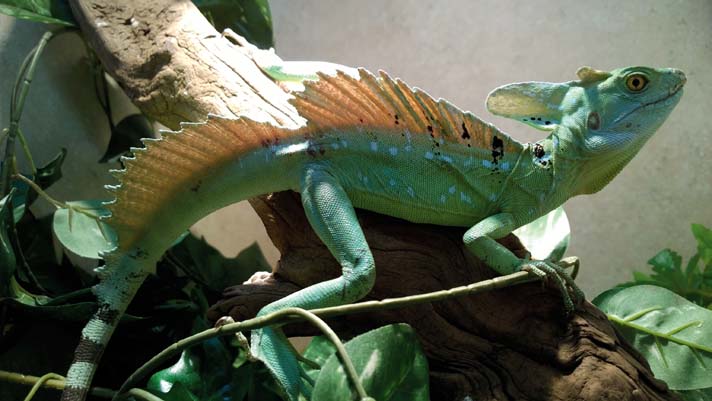
ryan chermel
The most striking feature of a green basilisk are the large dorsal crests than run down the back and tail.
Basilisk lizards are remarkable animals, ranging in color from various shades of red, green, blue, brown, yellow and black. They are predators that feed mostly on winged insects in the wild. They are well known for a unique behavior exhibited by wild specimens. By trapping pockets of air beneath their long toes and fringes of skin, and using their tails for balance, basilisks are able to run bipedally for short distances across the surface of water. This incredible trait—which has resulted in the nickname of “Jesus lizard”—not only allows basilisks to hunt more efficiently, it enables them to make a quick escape from predators themselves. And if a basilisk tires while making such as escape, it can reportedly remain underwater for up to 20 minutes depending on the severity of the threat it perceives (although in my experience, my basilisks will generally hide underwater for about five minutes before they pop their heads up to see what’s going on).
The most common basilisk seen in the pet reptile trade is the striped basilisk, due in part to the fact that it roams freely in Florida as an invasive species. Currently, specimens may sell for between $3 (for babies) and $20 (for adults) each. Because of its inexpensive price tag, plus the fact that the striped basilisk does not boast any amazing colors or truly enticing features to the untrained eye, some specimens I’ve seen for sale are not cared for properly and appear malnourished. This is unfortunate, because the striped basilisk, though not as eye-catching as the green basilisk, can still make an engaging pet.
Two Species of Basilisk Lizard
The green basilisk is a marvelous creature to behold, especially the males. It is common in humid lowlands of Costa Rica, Honduras, Nicaragua and Panama. Adult snout-to-vent lengths are usually 26 to 34 inches for males and 18 to 24 inches for females. As with most other lizards, the majority of a basilisk’s length is its long tail.
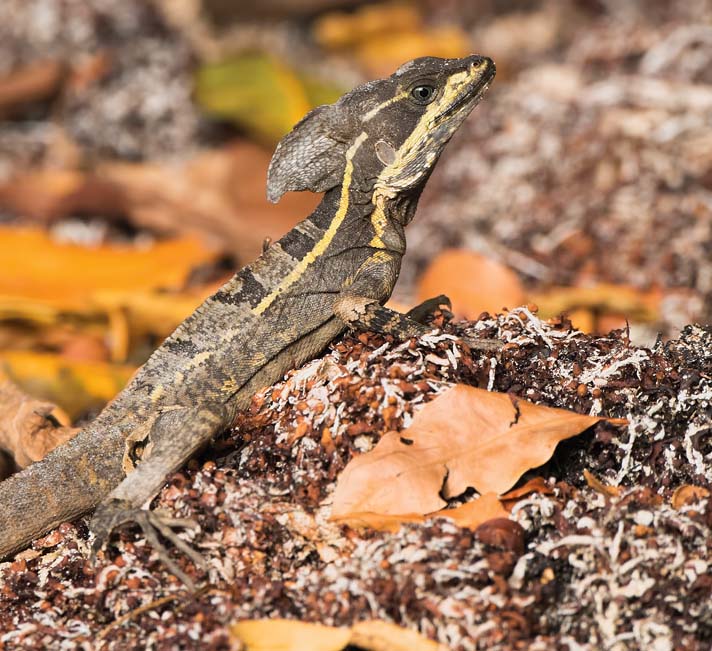
hopko/shutterstock
The striped basilisk is the most commonly seen species in the pet trade.
Generally speaking, a bright yellow iris is the prototypical standard for a green basilisk, although I have a female with red irises, which is quite remarkable. In addition to the usual yellow iris, the most striking feature of a green basilisk are the males’ prominent dorsal crests along the back and tail, as well as two crests that sit atop and slightly behind the head. Because of these impressive crests, I’ve heard people refer to the green basilisk as a “sailfin lizard” (not to be confused with Hydrosaurus species).
Many B. plumifrons boast incredible markings and color patterns, with variations of blue, black and white spattering the basilisk’s background color of rich, emerald green. The blue or white coloration is usually seen as a spotted pattern along the dorsal area of some individuals, whereas the black may appear as a barred pattern extending along the back to about the ribcage. Green meets a faded yellow on the ventral side of most specimens.
I have noticed something interesting while working with green basilisks in particular. The colors and crests of young males I have raised are not as impressive if they are not exposed to other males. They never retain their striking black markings or blue spots, and while their crests remain prominent, they are not as large or impressive. Noticing this, I tried raising males within sight of one another, and wouldn’t you know it, the colors of the young males remained true, and their crests, in almost all instances, grew taller. I suspect this may be due to the direct competition that the young animals may have felt they were engaged in with one another. I’ve also noticed that if I breed females with larger crests, I end up with bigger babies.
The striped basilisk’s range is from central Mexico south to northern Colombia. It is the smallest of the four species, with a maximum size topping out at around 18 to 22 inches for males and 14 to 17 inches for females (with a happy average being around 16 to 20 inches). The males lack the amazing back and tail crests of their green counterparts, although they do possess a very large head crest on the back of the head.
They also display a checkerboard pattern of black, white and brown, which varies in appearance from animal to animal, along with yellow and black stripes that extend from just behind the eye all the way down both sides to the vent. Most males have a salmon-colored belly that begins coloring up when they are juveniles. Females typically possess a charcoal-gray to silver belly, with a slight pink tone around the edges.
The average time that it takes for a striped basilisk to sexually mature can be as early as 10 months of age and as late as 15 months. While they are sexually mature at a young age, they normally are still not at adult size yet. Males of this species develop more slowly than the females.
It’s important to note that females of both striped and green basilisks are incredibly food aggressive. This means that if you are housing multiple young females together with one young male, he will develop slowly and may even get stressed into submission by the females. To prevent this, I recommend housing juvenile basilisks separately so that the males may grow at a healthy pace and become established before introducing them to the females. This is especially recommended when working with B. vittatus, because striped basilisk males are incredibly submissive and will prefer to hide than compete with females for food.
Basilisk Lizard Husbandry
A basilisk enclosure must be spacious. For an adult pair or trio, I recommend a vertically oriented glass-walled enclosure that is at least 3 feet long by 3 feet wide and 4 feet tall, with plenty of branches, etc. for climbing. In addition, because these lizards originate from a rain forest habitat, the enclosure should be equipped with some sort of humidity-producing system, whether this be a rainfall device or a fogger.
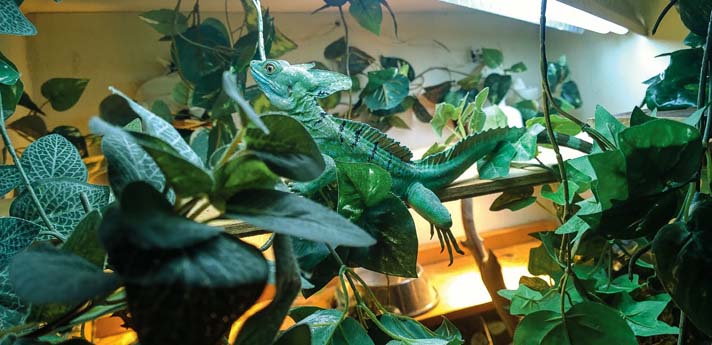
RYAN CHERMEL
Vegetation in a basilisk enclosure results in a more natural look and also offers security for the animals by providing hiding places.
In nature, basilisks live near water, and water should figure into their captive enclosures. I utilize a waterfall unit in my enclosures. Waterfalls not only look great, they help to maintain the proper level of humidity. Basilisks also feel most secure in a planted environment—provide either artificial plants or live, non-toxic species. These will not only help your basilisks to feel more secure by providing hiding places, plants also help maintain humidity. Hiding places are crucial for basilisks to feel secure.
Various substrates will work with basilisks. The types that retain some moisture are best, including orchid bark, cypress mulch, coconut coir and soil mixtures. It is very important to be sure that the type of substrate you choose is reptile friendly. Many types of soil are available, but some contain pesticides, fertilizers or perlite. The latter traps water, and while it may help live plants in the enclosure to retain moisture, a basilisk could die if it were to ingest enough perlite, or any pesticide or fertilizer.
Humidity and temperature levels depend on the season. During spring, I maintain the humidity in my basilisk enclosures at 55 to 60 percent, with an ambient cage temperature of 80 to 84 degrees Fahrenheit. In the summer, the humidity is raised to 65 to 75 percent with an ambient temperature of 83 to 86 degrees. When fall rolls around the humidity is dropped to 60 to 65 percent with temperatures of 80 to 83 degrees, and during winter humidity is 45 to 55 percent with temperatures between 75 and 80 degrees.
Regardless of the season, my adult basilisks always have access to a basking spot of 110 to 115 degrees. I use 60-watt halogen outdoor floodlights to provide this; they generate a lot of heat and last longer than traditional basking bulbs. I use 10.0 Reptisun bulbs to provide the necessary UVB. I installed dimmers on all of my light switches so I can control the intensity of the light during any particular season.
A 20-gallon long fish tank can house up to five hatchling basilisks. As their bodies grow, so do their personalities and temperaments, so it is highly recommended that you keep a close eye on growing basilisks in case you need to separate them. A small heat bulb that can produce a basking spot of 100 to 105 degrees is fine for babies, and again, a 10.0 Reptisun bulb is a must.
Prevent Nose Rubbing
A large enclosure does not only provide the space to create the perfect display enclosure, but it also reduces (and hopefully eliminates) the likelihood that your basilisk will engage in nose-rubbing behavior.
Captive basilisks are prone to rubbing their noses along the transparent walls of their enclosure, whether glass or Plexiglas, when they feel stressed from feeling exposed and in the open. Nose rubbing has long been linked to rostral trauma on many reptiles (green water dragons are notorious for it). Infections from open wounds caused by constant rubbing may also occur.
During a particularly severe scenario, in which a basilisk may actually run into one of the glass walls of its enclosure, think of what happens to the lizard’s body as similar to what occurs during a car crash. Whatever momentum the animal builds up results in its internal organs pushing forward when it comes to an abrupt halt by smashing into the glass. Because the majority of the contact is between the lizard’s face and the wall, its brain could even be at risk of injury, possibly leading to death.
A large enclosure and plenty of hiding places will greatly reduce the risk of nose-rubbing behavior. Some keepers will even go the extra mile by taping a solid barrier, such as a strip of cardboard or aquarium background material, along the bottom of any transparent walls. Lizards are less likely to push against a wall they can’t see through.
What to Feed a Basilisk Lizard
In my experience, feeding basilisks can be either incredibly frustrating or incredibly fascinating. If a wild-caught basilisk is what you bring home, then be aware of a few things. First, if the enclosure is not large enough, or does not have enough places in which the lizard can hide and feel safe, then the animal will most likely have a lethargic approach to eating. It may need an adjustment period before it begins feeding, and this can take as little as a week or as long as a few months. That said, unfortunately, there are also cases in which everything is done perfectly and the animal just never settles in.
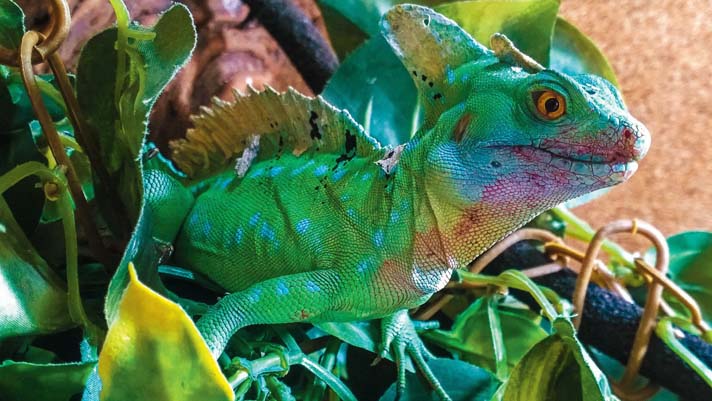
RYAN CHERMEL
Basilisks eat a wide variety of foods. This male green basilisk has just finished snacking on raspberries.
My first experience with green basilisks was with an imported pair. Once I got them settled into their enclosure, I immediately learned a few things. One of these was, as mentioned, that females are very aggressive when it comes to food. When I first offered some crickets to my new pair, the male was just making ready to grab one when the female suddenly leaped over him and grabbed not just one, but two crickets. She shook them viciously and jumped away with the crickets still in her mouth. The male basilisk, along with myself, could only watch in a shocked state of awe.
Male basilisks are timid when they are being watched, and for the first couple of weeks after you have brought one home, it more than likely will prefer to remain perched up in the rear of the enclosure, head-bobbing at you, rather then eat. Females, on the other hand, seldom, if ever, have an issue settling in and eating.
I feed adult basilisks a diet consisting mainly of crickets, superworms, berries (blackberries, raspberries, strawberries, blueberries), mango, cantaloupe, papaya, small minnows, night crawlers, dubia roaches, Zoo Med’s Can O’ Grasshoppers, and an occasional frozen/thawed pinky or fuzzy mouse (only one or two per month, per basilisk). Babies and juveniles are offered appropriately sized crickets, small mealworms and an occasional wax worm treat.
Through my years of trying to find the perfect diet for green basilisks, I have discovered that males love blackberries (females, however, may turn their noses up at fruit). Fruit should be kept to a minimum when feeding, though, and I recommend feeding it only to adults. Runny feces are very common in younger specimens if they’re given fruit.
If you bring home a captive-bred basilisk—and, of course, captive-bred animals are always recommended over wild-caught animals—the animal’s confidence and willingness to eat should already be there.
Dusting basilisk food items is a must. I dust with a calcium powder with D3 three times a week, and a vitamin supplement with beta-carotene the other four days. Beta-carotene is very important for basilisks because it helps maintain their colors. A green basilisk that is not given beta-carotene will begin fade to a lighter green color, and any blue spots will be hardly visible over time.
Basilisk Lizard Breeding Notes
In my experience, striped basilisks generally breed like rabbits. They usually reach sexual maturity somewhere between 10 and 15 months of age, and I have observed captive males constantly harrassing females to breed. When housing a trio, you can expect to receive a clutch of eggs every month, which is pretty insane when you think about it.
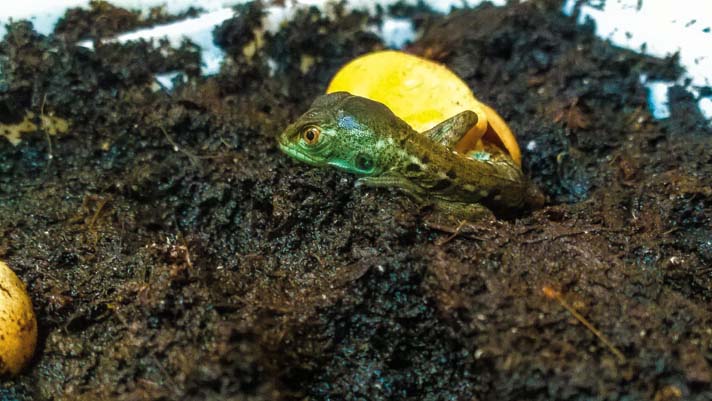
RYAN CHERMEL
A hatchling green basilisk emerges from its egg.
I learned that drying out their enclosure will really stimulate basilisks to breed regularly. Mine seem to breed best when their humidity ranges in the low 50s with an ambient temperature of 84 to 88 degrees. The average clutch size for a striped basilisk, in my experience, can normally be anywhere from five to 12 eggs, with the largest clutch that I ever hatched out being 14 eggs strong. Be forewarned: Because of their near-constant breeding, it is very easy to run out of space trying to accommodate dozens of striped basilisk hatchlings.
Green basilisk breeding occurs most commonly around the end of spring and the beginning of summer, with the first clutches of eggs being dropped at the end of May. During a good year, I can get three or four viable clutches of eight to 12 eggs from each pair, before they lay two infertile clutches right at the end of the season. I once got a clutch of 19 viable eggs, so green basilisks, too, can be fairly prolific breeders.
Captive-born basilisks that I have worked with always seem to have a longer breeding season, and are not as affected by changing conditions in their habitats. When breeding wild-caught animals, I’m usually collecting my last clutches of the season by the end of August. But when working with captive-bred bloodlines, I have gotten clutches as late as November.
A green basilisk generally reaches sexual maturity at 18 to 24 months of age, and the first few clutches that a young female lays are typically completely, or nearly completely, infertile (though there are always exceptions to this rule). I get my best hatch rates when incubating eggs at 86 to 88 degrees. This usually results in about 10 of 12 eggs hatching successfully and the hatchling surviving. For an incubation medium, I use a mixed substrate of coco fiber, vermiculite and organic soil with peat moss to maintain proper drainage and humidity. Basilisk eggs should be kept moist, but not soaking wet.
Ryan Chermel has worked with many reptile species, from Australian water dragons to Hydrosaurus. Not a day goes by when he does not learn something from them, and he considers it a joy and privilege to be able to keep and work with such marvelous creatures.


